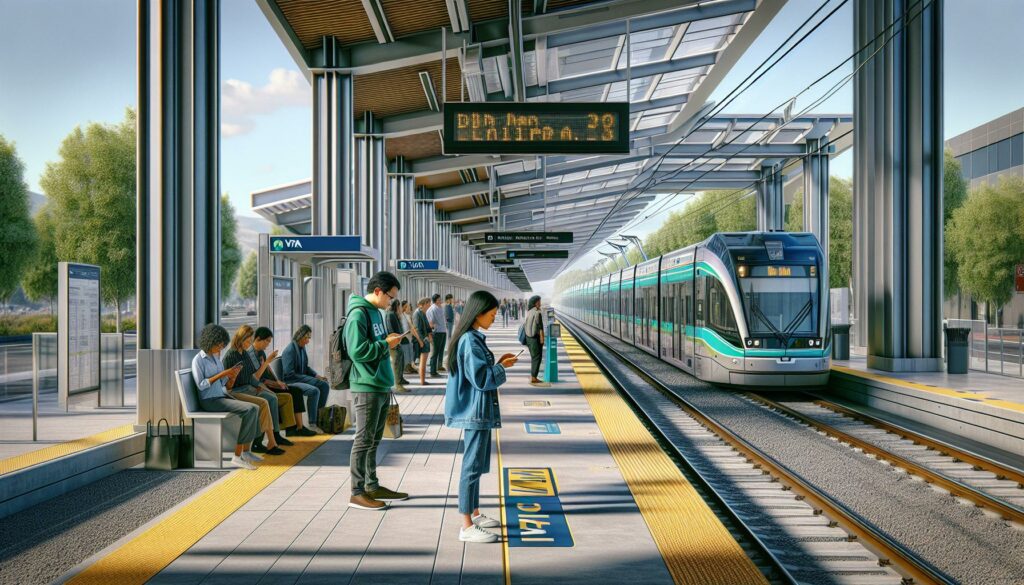As a frequent rider of San Jose’s public transportation system, I’ve witnessed firsthand how this network serves as the backbone of Silicon Valley’s mobility. The Valley Transportation Authority (VTA) operates an extensive system of buses and light rail trains that connect residents to key destinations across the South Bay Area.
I’ve found that navigating San Jose public transit opens up endless possibilities for both locals and visitors. From the bustling corridors of downtown to the tech campuses of North San Jose, the network provides essential links to jobs, education and entertainment. While many think of the Bay Area’s public transit as just BART or Caltrain, San Jose’s local system plays a crucial role in keeping Silicon Valley moving.
Key Takeaways
- VTA (Valley Transportation Authority) operates an extensive network of buses and light rail trains covering 346 square miles of Santa Clara County, with service running from 4:00 AM to 1:00 AM
- The system includes three light rail lines (Blue, Green, Orange) spanning 42.2 miles and 70 bus routes, connecting key destinations like downtown San Jose, tech campuses, and major shopping centers
- Fares range from $2.50 for single rides to $90 for monthly passes, with discounts available for seniors, youth, and disabled riders through Clipper Cards or the VTA EZfare Mobile App
- Major transit hubs include Diridon Station and Downtown Transit Mall, offering connections to regional services like Caltrain, Amtrak, and the upcoming BART Silicon Valley Extension
- Recent improvements include track replacements, digital displays, and plans for electric bus integration, with major projects like the BART Phase II extension scheduled for completion by 2030
San Jose Public Transit
The VTA manages an integrated network of light rail trains and buses throughout Santa Clara County. I’ve observed the system’s strategic design connecting residential neighborhoods industrial parks tech campuses shopping centers.
VTA Light Rail Network
The VTA Light Rail spans 42.2 miles across three main lines – Blue Green Orange. Here’s a breakdown of the network:
| Line | Route | Key Destinations |
|---|---|---|
| Blue | Alum Rock to Santa Teresa | Downtown San Jose Convention Center Civic Center |
| Green | Old Ironsgate to Winchester | Downtown Mountain View Santa Clara University |
| Orange | Mountain View to Alum Rock | Levi’s Stadium Silicon Valley Tech Campuses |
Operating hours run from 4:30 AM to midnight with trains arriving every 15-20 minutes during peak hours. The system serves 60+ stations equipped with ticket vending machines digital displays covered waiting areas.
Bus Routes and Service Areas
VTA operates 70 bus routes categorized into:
- Regular Routes: Connecting residential areas to transit centers business districts
- Express Routes: Direct service between park-and-ride lots major employment centers
- Limited Stop Service: Peak-hour routes with fewer stops for faster commutes
- Community Routes: Local circulation within specific neighborhoods
The bus network covers 346 square miles with service extending to:
- Downtown San Jose
- San Jose State University
- Norman Y. Mineta International Airport
- Stanford Shopping Center
- Great Mall of Milpitas
- Major tech campuses in Santa Clara
Buses run from 4:00 AM to 1:00 AM with 10-15 minute frequencies on popular routes during peak hours. Each bus features bike racks wheelchair accessibility real-time tracking capabilities.
Getting Around San Jose by Public Transit
Using San Jose public transit requires understanding the fare structure, payment methods, and service schedules. I’ve compiled essential information based on my extensive experience navigating the VTA system throughout Santa Clara County.
Fares and Payment Options
VTA offers multiple fare types and convenient payment methods for different transit needs:
- Single Ride: $2.50 for adults, $1.25 for youth (5-18), seniors (65+) & disabled riders
- Day Pass: $7.50 for adults, $3.75 for eligible discount riders
- Monthly Pass: $90 for adults, $45 for eligible discount riders
- Clipper Card: Reloadable smart card for contactless payment across Bay Area transit
- VTA EZfare Mobile App: Digital tickets purchased through smartphone
- Express Bus Premium: Additional $2.50 for express routes
Service Hours and Frequency
VTA maintains consistent schedules across its network:
Light Rail:
- Weekday Hours: 4:30 AM – 12:00 AM
- Weekend Hours: 5:00 AM – 12:00 AM
- Peak Frequency: 15 minutes (6:00 AM – 9:00 AM, 3:00 PM – 6:00 PM)
- Off-Peak Frequency: 20-30 minutes
- Weekday Hours: 4:00 AM – 1:00 AM
- Weekend Hours: 5:00 AM – 12:00 AM
- Core Routes Frequency: 10-15 minutes during peak hours
- Local Routes Frequency: 30-60 minutes throughout service hours
Key Transit Hubs and Stations
San Jose’s transit infrastructure centers around strategic transportation hubs that connect multiple transit services. These major stations serve as essential transfer points for VTA light rail, buses, Caltrain, Amtrak & regional transit services.
Diridon Station
Diridon Station operates as San Jose’s central multimodal transportation hub at 65 Cahill Street. The station connects VTA light rail’s Green Line with Caltrain, Amtrak Capitol Corridor, ACE trains & multiple VTA bus routes. This historic depot features:
- 5 platforms serving regional & intercity rail services
- Direct VTA bus connections to 7 regular & express routes
- Light rail access via the Green Line platform on Cahill Street
- 581 parking spaces for transit users
- Secured bicycle storage facilities with 230 spaces
Downtown Transit Mall
The Downtown Transit Mall stretches along 1st & 2nd Streets between San Carlos & Santa Clara Streets. This dedicated transit corridor includes:
- 3 light rail lines (Blue, Green & Orange) converging at key stations
- 23 bus routes connecting at various stops along the mall
- Real-time arrival displays at each station platform
- 4 major transfer points:
- Santa Clara Station
- Convention Center Station
- Paseo de San Antonio Station
- San Fernando Station
Each station features covered waiting areas, ticket vending machines & digital information displays. I find the clear signage & frequent service intervals make transfers particularly efficient at these locations.
Connecting to Regional Transit Systems
San Jose’s VTA system integrates seamlessly with major Bay Area transit networks through strategic connection points. These connections enhance mobility across the entire region through coordinated schedules and shared transit hubs.
Caltrain Integration
The VTA light rail connects directly with Caltrain at three key stations: Diridon Station, Mountain View Transit Center and Tamien Station. Caltrain provides regular service between San Jose and San Francisco with 30-minute frequencies during peak hours. I’ve found the following transfer options particularly efficient:
- Cross-platform transfers at Mountain View Station connect to Caltrain’s most frequent Baby Bullet express service
- Direct bus connections from VTA routes 22, 64 and 68 to Caltrain platforms at Diridon
- Synchronized arrival times between VTA light rail and Caltrain during weekday commute hours
- Shared Clipper Card payment system for seamless transfers between systems
BART Extension Plans
The BART Silicon Valley Extension project expands regional connectivity through two phases:
Phase 1 (Completed 2020):
- 10-mile extension from Fremont to Berryessa/North San Jose
- Two new stations: Milpitas and Berryessa/North San Jose
- Direct VTA bus connections to both stations
- 30-minute travel time to downtown San Francisco
Phase 2 (Under Construction):
- 6-mile extension from Berryessa to downtown San Jose
- Four new stations: 28th Street/Little Portugal, Downtown San Jose, Diridon and Santa Clara
- Estimated completion: 2030
- Underground tunnel design through downtown San Jose
- Integration with existing VTA light rail at Diridon Station
The completed extension connects San Jose directly to the broader BART network spanning San Francisco, Oakland and the East Bay with trains running every 7.5 minutes during peak hours.
Recent Improvements and Future Projects
The VTA implements continuous system upgrades through strategic infrastructure improvements and service expansion initiatives. I’ve tracked several significant developments that enhance San Jose public transit network.
Transit Infrastructure Updates
The VTA completed a $24.4 million light rail track replacement project in 2023, upgrading 7 miles of aging rails along the Blue Line corridor. I’ve observed these key infrastructure improvements:
- Installation of 40 new digital real-time arrival displays at major stations
- Implementation of contactless fare payment systems at 60 light rail platforms
- Renovation of 12 bus stops with enhanced lighting and weather protection
- Addition of 3 new electric bus charging stations at Cerone Division yard
- Upgrade of signal priority systems at 25 intersections for improved bus timing
- Extension of Orange Line service to North San Jose tech corridor by 2025
- Addition of 4 new rapid bus routes connecting East San Jose neighborhoods
- Integration of 100 electric buses into the fleet by 2026
- Construction of the BART Silicon Valley Phase II with 4 new stations
- Development of 2 transit-oriented communities near Berryessa station
| Project | Completion Date | Investment (Millions) |
|---|---|---|
| Track Replacement | 2023 | $24.4 |
| Digital Displays | 2024 | $8.5 |
| Electric Bus Fleet | 2026 | $120 |
| BART Phase II | 2030 | $6,900 |
Tips for Using San Jose Public Transit
I’ve compiled essential tips for navigating San Jose’s public transit system based on my extensive experience using VTA services. These practical guidelines maximize the efficiency of your transit experience while ensuring a comfortable journey.
Trip Planning Resources
The VTA Transit app provides real-time arrival predictions for buses and light rail. I access schedules through google.maps.vta.org or download PDF timetables from VTA’s website. Here are key planning tools:
- VTA’s official website displays service alerts system-wide disruptions
- Transit Signal Priority tracking shows exact bus locations on major routes
- Google Maps integrates VTA schedules with walking directions to stops
- Clipper Card website manages fare balance online
- VTA Customer Service hotline operates 6 AM-7 PM weekdays at (408) 321-2300
Transit Safety and Etiquette
Transit security maintains passenger safety through regular patrols surveillance cameras. I follow these established protocols:
- Remain behind yellow safety strips on light rail platforms
- Keep belongings close secure valuables when traveling
- Exit through rear doors on buses during peak hours
- Yield priority seating to seniors disabled passengers
- Move to the back of vehicles during crowded times
- Remove backpacks place them between feet
- Keep phone conversations brief quiet
- Report suspicious activity to transit personnel or through VTA’s security app
| Location | Security Measure |
|---|---|
| Stations | 24/7 cameras emergency call boxes |
| Vehicles | GPS tracking onboard cameras |
| Platforms | Security lighting patrol checks |
| Bus Stops | Direct line to dispatch shelter lighting |
Transportation System
San Jose public transit system stands as a cornerstone of Silicon Valley’s transportation infrastructure. Through my extensive use of VTA services I’ve witnessed firsthand how this network continues to evolve and improve. The combination of light rail trains buses and strategic transit hubs creates a reliable foundation for both daily commuters and occasional riders.
The ongoing expansion projects and technological upgrades demonstrate VTA’s commitment to meeting the growing needs of San Jose’s diverse population. I’m confident that as these improvements continue to roll out the system will become even more efficient and user-friendly making public transit an increasingly attractive option for getting around Silicon Valley.

